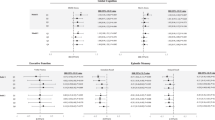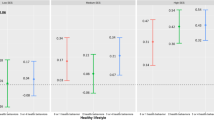Abstract
Background
2,4-Dichlorophenoxyacetic acid (2,4-D) is reported to be the most widely used herbicide in home and garden environments, rendering it commonly encountered in daily life. Despite being ubiquitous, there is a scarcity of studies that have comprehensively assessed the relationship between 2,4-D exposure and cognition using multiple models.
Objective
To explore the association between 2,4-D exposure and cognition among older American people.
Methods
This was a cross-sectional study that included 3 cycles of data from the National Health and Nutrition Examination Survey. Generalized linear models (GLMs), restricted cubic spline (RCS) regression, and generalized additive models (GAMs) were used to assess the relationship between exposure to 2,4-D and cognitive performance by the Consortium to Establish a Registry for Alzheimer’s Disease (CERAD) word learning sub-test, Digit Symbol Substitution Test (DSST), and Animal Fluency Test (AFT).
Results
A total of 1364 older U.S. adults (60+ years) were included in the study. The GLMs revealed a negative association between median high levels (0.315–0.566 μg/L) of 2,4-D and cognitive impairment on the DSST and AFT, with multivariate-adjusted ORs of 0.403 (95% CI: 0.208–0.781, P = 0.009) and 0.396 (95% CI: 0.159–0.986, P = 0.047); the RCS regression and GAMs revealed a “U” shaped curve, the left part of which is consistent with the result of the GLMs.

Impact statement
There is a U-shaped relationship between human urinary 2,4-D concentrations and cognitive impairment in older U.S. adults, especially in males, so controlling 2,4-D exposure within an appropriate range is particularly important for cognitive function.
This is a preview of subscription content, access via your institution
Access options
Subscribe to this journal
Receive 6 print issues and online access
$259.00 per year
only $43.17 per issue
Buy this article
- Purchase on Springer Link
- Instant access to full article PDF
Prices may be subject to local taxes which are calculated during checkout



Similar content being viewed by others
Data availability
The datasets generated for this study are available from https://www.cdc.gov/nchs/nhanes.
References
Peterson MA, McMaster SA, Riechers DE, Skelton J, Stahlman PW. 2,4-D past, present, and future: a review. Weed Technol. 2017;30:303–345.
Aquino AJA, Tunega D, Habephauer G, Gerzabek MH, Lischka H. Interaction of the 2.4-dichlorophenoxyacetic acid herbicide with soil organic matter moieties: a theoretical study. Eur J Soil Sci. 2007;58:889–99.
Freisthler MS, Robbins CR, Benbrook CM, Young HA, Haas DM, Winchester PD, et al. Association between increasing agricultural use of 2,4-D and population biomarkers of exposure: findings from the National Health and Nutrition Examination Survey, 2001-2014. Environ Health. 2022;21:23.
USEP Agency. Pesticides industry sales and usage 2008–2012 market estimates. 2015. Available from: https://www.epa.gov/pesticides/pesticides-industry-sales-and-usage-2008-2012-market-estimates.
Favreault MM, Johnson RW. The risk and costs of severe cognitive impairment at older ages: key findings from our literature review and projection analyses. ASPE. 2021. https://aspe.hhs.gov/reports/risk-costs-severe-cognitive-impairment-older-ages-key-findings-our-literature-review-projection.
Centers for Disease Control and Prevention. The healthy brain initiative: the public health road map for state and national partnerships, 2013–2018, Interim Progress Report. Atlanta, GA: CDC; 2015.
Anton BJ, Dehnert GK, Karasov WH. Subchronic impacts of 2,4-D herbicide Weedestroy (R) AM40 on associative learning in juvenile yellow perch (Perca flavescens). Aquat Toxicol. 2021;237:105909.
Ueda RMR, de Souza VM, Magalhaes LR, Chagas PHN, Veras ASC, Teixeira GR, et al. Neurotoxicity associated with chronic exposure to dichlorophenoxyacetic acid (2,4-D) - a simulation of environmental exposure in adult rats. J Environ Sci Health Part B Pesticides Food Contam Agric Wastes. 2021;56:695–705.
National Center for Health Statistics, National Health and Nutrition Examination Survey (NHANES). Questionnaires, datasets, and related documentation. 2015. www.cdc.gov/nchs/nhanes/nhanes_questionnaires.htm.
Centers for Disease Control and Prevention, National Center for Health Statistics, National Health and Nutrition Examination Survey 2011–2012, Data Documentation, Codebook, and Frequencies, Cognitive Functioning (CFQ_G). 2017. https://wwwn.cdc.gov/Nchs/Nhanes/2011-2012/CFQ_G.htm.
Centers for Disease Control and Prevention, National Center for Health Statistics, National Health and Nutrition Examination Survey, 2013–2014 Data Documentation, Codebook, and Frequencies, Cognitive Functioning (CFQ_H). 2017. https://wwwn.cdc.gov/Nchs/Nhanes/2013-2014/CFQ_H.htm.
Brody DJ, Kramarow EA, Taylor CA, McGuire LC. Cognitive performance in adults aged 60 and over: National Health and Nutrition Examination Survey, 2011-2014. Natl Health Stat Rep. 2019;2019:1–23.
Jaeger J. Digit symbol substitution test: the case for sensitivity over specificity in neuropsychological testing. J Clin Psychopharmacol. 2018;38:513–9.
Amaresha AC, Danivas V, Shivakumar V, Agarwal SM, Kalmady SV, Narayanaswamy JC, et al. Clinical correlates of parametric digit-symbol substitution test in schizophrenia. Asian J Psychiatry. 2014;10:45–50.
Morris JC, Heyman A, Mohs RC, Hughes JP, van Belle G, Fillenbaum G. et al., The Consortium to Establish a Registry for Alzheimer’s Disease (CERAD). Part I. Clinical and neuropsychological assessment of Alzheimer’s disease. Neurology. 1989;39:1159–65.
Canning SJD, Leach L, Stuss D, Ngo L, Black SE. Diagnostic utility of abbreviated fluency measures in Alzheimer disease and vascular dementia. Neurology. 2004;62:556–62.
Sotaniemi M, Pulliainen V, Hokkanen L, Pirttila T, Hallikainen I, Soininen H, et al. CERAD-neuropsychological battery in screening mild Alzheimer’s disease. Acta Neurologica Scandinavica. 2012;125:16–23.
Dong X, Li SR, Sun J, Li Y, Zhang DF. Association of Coffee, Decaffeinated Coffee and Caffeine Intake from Coffee with Cognitive Performance in Older Adults: National Health and Nutrition Examination Survey (NHANES) 2011-2014. Nutrients. 2020, 12. https://doi.org/10.3390/nu12030840.
Chen SP, Bhattacharya J, Pershing S. Association of vision loss with cognition in older adults. JAMA Ophthalmol. 2017;135:963–70.
Li SY, Sun WJ, Zhang DF. Association of zinc, iron, copper, and selenium intakes with low cognitive performance in older adults: a cross-sectional study from National Health and Nutrition Examination Survey (NHANES). J Alzheimers Dis. 2019;72:1145–57.
Sauerhoff MW, Braun WH, Blau GE, Gehring PJ. Fate of 2,4-Dichlorophenoxyacetic Acid (2,4-d) following oral-administration to man. Toxicology. 1977;8:3–11.
Hill RH, Shealy DB, Head SL, Williams CC, Bailey SL, Gregg M, et al. Determination of pesticide metabolites in human urine using an isotope-dilution technique and tandem mass-spectrometry. J Anal Toxicol. 1995;19:323–9.
Cole SR, Chu HT, Nie L, Schisterman EF. Estimating the odds ratio when exposure has a limit of detection. Int J Epidemiol. 2009;38:1674–80.
Wang W, Ma Y, Chen J, Peng L, Gao X, Lin L, et al. The association between 2, 4-Dichlorophenoxyacetic acid and erectile dysfunction. Front Public Health. 2022;10:910251.
Dinu M, Colombini B, Pagliai G, Vannetti F, Pasquini G, Molino Lova R, et al. BMI, functional and cognitive status in a cohort of nonagenarians: results from the Mugello study. Eur Geriatr Med. 2021;12:379–86.
Topiwala A, Ebmeier KP. Effects of drinking on late-life brain and cognition. Evid Based Ment Health. 2018;21:12–15.
Swan GE, Lessov-Schlaggar CN. The effects of tobacco smoke and nicotine on cognition and the brain. Neuropsychol Rev. 2007;17:259–73.
Dove A, Shang Y, Xu WL, Grande G, Laukka EJ, Fratiglioni L, et al. The impact of diabetes on cognitive impairment and its progression to dementia. Alzheimers Dement. 2021;17:1769–78.
Iadecola C, Gottesman RF. Neurovascular and cognitive dysfunction in hypertension epidemiology, pathobiology, and treatment. Circ Res. 2019;124:1025–44.
Walker KA, Power MC, Gottesman RF. Defining the relationship between hypertension, cognitive decline, and dementia: a review. Curr Hypertens Rep. 2017;19. https://doi.org/10.1007/s11906-017-0724-3.
Lo Coco D, Lopez G, Corrao S. Cognitive impairment and stroke in elderly patients. Vasc Health Risk Manag. 2016;12:105–16.
van Vliet P. Cholesterol and late-life cognitive decline. J Alzheimers Dis. 2012;30:S147–S162.
Tana C, Ticinesi A, Prati B, Nouvenne A, Meschi T. Uric acid and cognitive function in older individuals. Nutrients. 2018, 10. https://doi.org/10.3390/nu10080975.
Llewellyn DJ, Langa KM, Friedland RP, Lang IA. Serum albumin concentration and cognitive impairment. Curr Alzheimer Res. 2010;7:91–96.
Prevention CfDCa. NHANES Survey Methods and Analytic Guidelines. 2020. https://wwwn.cdc.gov/nchs/nhanes/analyticguidelines.aspx. Accessed 26 Oct 2021.
Lusa L, Ahlin Č. Restricted cubic splines for modelling periodic data. PloS One. 2020;15:e0241364.
Lin X, Zhang D. Inference in generalized additive mixed modelsby using smoothing splines. J R Stat Soc. 1999;61:381–400.
Conolly RB, Lutz WK. Nonmonotonic dose-response relationships: mechanistic basis, kinetic modeling, and implications for risk assessment. Toxicological Sci. 2004;77:151–7.
Kohn M, Melnick R. Biochemical origins of the non-monotonic receptor-mediated dose-response. J Mol Endocrinol. 2002;29:113–23.
Park SK, Ding N, Han D. Perfluoroalkyl substances and cognitive function in older adults: should we consider non-monotonic dose-responses and chronic kidney disease? Environ Res. 2021;192:110346.
Freitas LM, Valadares LA, Camozzi M, de Oliveira PG, Ferreira Machado MR, Lima FC, et al. Animal models in the neurotoxicology of 2,4-D. Hum Exp Toxicol. 2019;38:1178–82.
Elo HA, MacDonald E. Effects of 2,4-dichlorophenoxyacetic acid (2,4-D) on biogenic amines and their acidic metabolites in brain and cerebrospinal fluid of rats. Arch Toxicol. 1989;63:127–30.
Cifariello A, Pompili A, Gasbarri A. 5-HT(7) receptors in the modulation of cognitive processes. Behav Brain Res. 2008;195:171–9.
Zafeiridou G, Geronikaki A, Papaefthimiou C, Tryfonos M, Kosmidis EK, Theophilidis G, et al. Assessing the effects of the three herbicides acetochlor, 2,4,5-trichlorophenoxyacetic acid (2,4,5-T) and 2,4-dichlorophenoxyacetic acid on the compound action potential of the sciatic nerve of the frog (Rana ridibunda). Chemosphere. 2006;65:1040–8.
Sharifi Pasandi M, Hosseini Shirazi F, Gholami MR, Salehi H, Najafzadeh N, Mazani M, et al. Epi/perineural and Schwann cells as well as perineural sheath integrity are affected following 2,4-D exposure. Neurotox Res. 2017;32:624–38.
Kadekar S, Peddada S, Silins I, French JE, Högberg J, Stenius U. Gender differences in chemical carcinogenesis in National Toxicology Program 2-year bioassays. Toxicol Pathol. 2012;40:1160–8.
Barahona AJ, Bursac Z, Veledar E, Lucchini R, Tieu K, Richardson JR. Relationship of blood and urinary manganese levels with cognitive function in elderly individuals in the United States by race/ethnicity, NHANES 2011-2014. Toxics. 2022;10. https://doi.org/10.3390/toxics10040191.
Sasaki N, Carpenter DO. Associations between metal exposures and cognitive function in American older adults. Int J Environ Res Public Health. 2022;19. https://doi.org/10.3390/ijerph19042327.
Krieg EF Jr. The relationships between pesticide metabolites and neurobehavioral test performance in the third National Health and Nutrition Examination Survey. Arch Environ Occup Health. 2013;68:39–46.
National Academies of Sciences, Engineering, and Medicine; Health and Medicine Division; Board on Population Health and Public Health Practice; Committee to Review the Health Effects in Vietnam Veterans of Exposure to Herbicides (Eleventh Biennial Update). Veterans and Agent Orange: Update 11 (2018). Washington (DC): National Academies Press (US); 2018.
Sauerhoff MW, Braun WH, Blau GE, Gehring PJ. The fate of 2,4-dichlorophenoxyacetic acid (2,4-D) following oral administration to man. Toxicology. 1977;8:3–11.
Ye X, Pierik FH, Hauser R, Duty S, Angerer J, Park MM, et al. Urinary metabolite concentrations of organophosphorous pesticides, bisphenol A, and phthalates among pregnant women in Rotterdam, the Netherlands: the Generation R study. Environ Res. 2008;108:260–7.
Trasande L, Liu B, Bao W. Phthalates and attributable mortality: A population-based longitudinal cohort study and cost analysis. Environ Pollut. 2022;292:118021.
Acknowledgements
We thank all the researchers who participated in this study.
Author information
Authors and Affiliations
Contributions
XZ: Conceptualization, Methodology, Formal analysis, Writing original draft. YS: Methodology, Formal analysis. JS: Writing original draft. QY: Validation, Supervision. FL: Conceptualization, Supervision, Interpreted the data, Reviewed and improved the draft manuscript. GC: Conceptualization, Supervision, Interpreted the data, Reviewed and improved the draft manuscript.
Corresponding authors
Ethics declarations
Competing interests
The authors declare no competing interests.
Ethical approval
The consent form was signed by participants in the survey, and participants consented to storing specimens of their blood for future research. The CDC/NCHS Ethics Review Board (ERB) approved the NHANES study and gave approval for public dissemination.
Additional information
Publisher’s note Springer Nature remains neutral with regard to jurisdictional claims in published maps and institutional affiliations.
Supplementary Information
Rights and permissions
Springer Nature or its licensor (e.g. a society or other partner) holds exclusive rights to this article under a publishing agreement with the author(s) or other rightsholder(s); author self-archiving of the accepted manuscript version of this article is solely governed by the terms of such publishing agreement and applicable law.
About this article
Cite this article
Zou, X., Shi, Y., Su, J. et al. Association between 2,4-dichlorophenoxyacetic acid and cognitive impairment in older adults: a cross-sectional study from NHANES 2001–2002 and 2011–2014. J Expo Sci Environ Epidemiol (2023). https://doi.org/10.1038/s41370-023-00628-9
Received:
Revised:
Accepted:
Published:
DOI: https://doi.org/10.1038/s41370-023-00628-9



